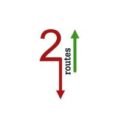Analyzing a trading chart can seem overwhelming at first, but it’s essentially about understanding past price movements and identifying potential future trends. Here’s a breakdown of basic chart analysis for beginners:
1. Choose your chart:
- Candlestick: Most popular, showing open, high, low, and close prices for each time period. Green for up days, red for down days.
- Line chart: Simpler view, just showing closing prices.
- Bar chart: Similar to candlestick, Vertical bars.
2. Identify key elements:
- Price axis: Vertical axis showing price levels.
- Time axis: Horizontal axis showing time periods (minutes, hours, days, etc.).
- Trendlines: Diagonal lines connecting highs or lows, indicating upward or downward trends.
- Support and resistance: Horizontal lines indicating price levels where buying/selling activity concentrates, potentially stopping or reversing price movements.
- Moving averages: Lines smoothening out price fluctuations, helping identify overall trends.
3. Analyze price movements:
- Look for trends: Are prices generally rising (uptrend), falling (downtrend), or sideways (ranging)?
- Identify reversals: Are there sudden changes in direction? Consider trendlines, support/resistance levels, and volume changes.
- Use indicators: Technical indicators like Relative Strength Index (RSI) or Bollinger Bands can provide additional insights into momentum, volatility, and potential overbought/oversold conditions.
4. Remember:
- Point to be noted: Past performance doesn’t guarantee future results.
- Combine technical analysis with other factors: Fundamental analysis (company financials, economic data) can give broader context.
- Risk management is crucial: Set stop-loss orders to limit potential losses.
- Choose the right timeframe for your strategy. Different timeframes can reveal different trends and patterns. For example, a short-term timeframe may be better suited for day trading, while a long-term timeframe may be better suited for swing trading or investing.
- Use multiple indicators together to increase reliability. No single indicator is perfect, so it’s important to use multiple indicators together to get a more complete picture of the market.
- Practice technical analysis regularly. The more you practice, the better you’ll become at spotting trends and patterns.
- Be aware of false signals. Even the best indicators can generate false signals. It’s important to be aware of these signals.
- Track news and economic events that may affect the market. News and economic events can have a significant impact on market prices. It’s important to stay up-to-date on these events so that you can make informed trading decisions.
- Start with the basics. Before you start using complex indicators, it’s important to understand the basics of technical analysis. This includes understanding the different types of charts, the key elements of a chart, and the different types of trends and patterns.
- Backtest your strategies. Before you start trading with real money, it’s important to backtest your strategies to see how they perform over time. This will help you identify any flaws in your strategy and make necessary adjustments.
- Be patient. Technical analysis is a skill that takes time and practice to master. Don’t expect to become a successful trader overnight.
Start with these basics and gradually deepen your understanding of technical analysis as you progress. Remember, practice and research are key to developing your own trading strategies and making informed decisions based on chart analysis.
